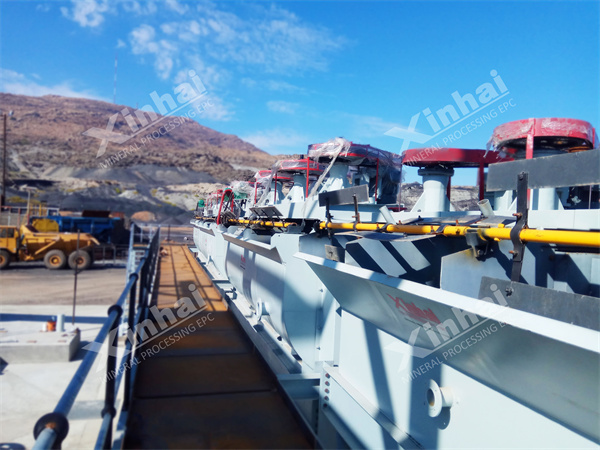If you want to know more information (such as product/process price, etc.), please contact us 24-hour telephone
As high-grade spodumene resources become increasingly scarce, efficient enrichment technologies for low-grade ores have become a critical technical challenge in the global lithium industry. The enrichment of low-grade lithium ores requires a scientific experimental design, advanced pre-treatment processes, and the organic integration of innovative flotation technologies. This article focuses on breakthroughs in beneficiation efficiency through novel combined processes and core technological innovations.
1.1 Optimization of Key Parameters
A three-dimensional experimental design model was used to quantitatively analyze the synergistic effects of grinding fineness (-200 mesh content of 65-75%), pH control window (8.5-9.2), and composite reagent gradients (collector dosage of 0.8-1.2 kg/t). The response surface methodology (RSM) was applied to establish a multi-factor interaction model, determining the optimal flotation kinetic parameters.
1.2 Closed-Circuit Process Validation
A dynamic closed-circuit experimental system was constructed to simulate industrial-scale process conditions, including circulating water treatment and middlings recirculation. A 72-hour continuous stability test confirmed that the Li₂O recovery rate remained stable at 82.3% ± 1.5%, with a concentrate grade reaching 5.8%.
2.1 Advanced Desliming Technology
A combination of a high-frequency vibrating screen (2000 r/min) and a hydrocyclone (0.15 MPa pressure) achieved a -10μm slime removal rate of over 85%. The introduction of surface modification agents effectively suppressed the fine particle covering effect, reducing slurry viscosity by 37%.
2.2 Selective Liberation Process
A staged grinding-magnetic pre-selection system was developed, utilizing high-pressure grinding rolls (4.5 MPa) to achieve differential liberation of spodumene, feldspar, and quartz. XRD analysis showed that the target mineral's monomer liberation rate increased to 91.2%, while grinding energy consumption was reduced by 22%.

3.1 Innovative Flotation Flowsheet
A dynamic control strategy of "rapid roughing collection—deep purification in cleaning" was implemented, with an innovative flotation column-flotation machine combination. Online grade analyzers were used to dynamically adjust the process, reducing the number of cleaning stages by two and lowering the Li₂O loss rate by 4.7 percentage points.
3.2 Intelligent Reagent System
Molecularly Designed Collectors: Chelating collectors containing sulfonic acid groups were developed, achieving an adsorption energy of -58.6 kJ/mol on spodumene at pH 9.0.
Eco-Friendly Depressants: Bio-based depressants (modified cellulose) replaced traditional phosphates, increasing inhibition efficiency by 19% while reducing COD emissions by 65%.
Smart Responsive Regulators: Temperature-sensitive pH regulators enabled self-balanced control of slurry alkalinity.
4.1 Combined Beneficiation
A "gravity pre-enrichment–magnetic impurity removal–flotation refinement" system was developed, incorporating a novel suspension roasting (650°C) modification-magnetic separation (1.2T) process. This method achieved an iron-lithium mica removal rate of over 93%.
4.2 Enhanced Flotation
By optimizing flotation conditions, including increased agitation intensity and precise reagent dosage control, flotation performance was enhanced. This approach improved flotation efficiency, shortened flotation time, reduced production costs, and increased overall economic benefits.
5.1 Advanced Pre-Treatment Technologies
Enhanced pre-treatment prior to flotation, such as magnetic separation for removing magnetic gangue minerals and flotation for eliminating easily floatable gangue, significantly reduces flotation burdens and improves flotation efficiency and recovery rates.
5.2 Next-Generation Collectors
The development and application of novel collectors, such as chelating and combined collectors, are key to improving the enrichment efficiency of low-grade spodumene. These new collectors enhance spodumene selectivity and collection capacity, effectively addressing the challenges posed by complex ore compositions.
Industrial Application
Leveraging proprietary XHP-series flotation equipment and intelligent control systems, Xinhai Mining has established a demonstration production line at a large lithium mine in China. Industrial-scale operation data indicate that processing raw ore with 0.8% Li₂O achieved a concentrate grade of 6.2% and a recovery rate of 84.3%, setting industry-leading benchmarks while reducing unit energy consumption by 35% compared to conventional processes. The company’s EPCM+O service model, covering everything from mineralogical analysis to intelligent plant operation, provides comprehensive engineering solutions for maximizing resource utilization globally.